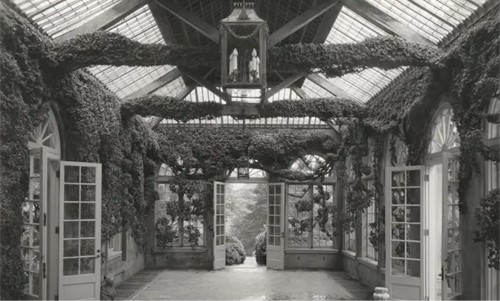If I were to leave Washington, the place I would miss the most would be the garden at Dumbarton Oaks. To those of us who know and love this landscape gem in Georgetown, such a declaration may seem like a statement of the obvious. It is one of the great gardens of America, known by landscape designers and historians around the world, cherished by a protective cadre of neighbors, but generally not as well known as it deserves to be in the nation’s capital. The garden is open to the public, but Dumbarton Oaks is an academic research institute and has something of the forbidding ivory tower about it.
What do I like about the garden? Almost everything. The design, the trees, the garden rooms, the craftsmanship, the intellectual underpinnings and historical references, and the fact that the landscape is one of both variety and unity. If ever a garden was a work of art, this is it.
The hillside of massed forsythia is a blast from the past and the double herbaceous border slopes disagreeably, but otherwise the garden is, quite simply, a place that lifts you up and makes you feel good to be alive. The 16-acre ensemble is so refined that it transcends the period in which it was made, but we need to put aside this timeless quality for a moment and reflect on its origins and the two remarkable women — patron and designer — who created it a century ago.
The centennial is a moving target. Mildred Bliss and her husband, Robert Bliss, bought the estate in 1920; the designer, Beatrix Jones Farrand, first visited in 1921 but didn’t lay out her vision of the garden until 1922. It took the rest of that decade to reach the form we now recognize, and major additions to the house complex and some significant garden alterations occurred after the Blisses gave the property to Harvard University in 1940, and after Farrand bowed out.
When Farrand shared her concept in 1922, of garden spaces threaded between existing old trees, Bliss wrote back to say it made her “purr with contentment.” The language might suggest one dilettante in conversation with another, but both women defied such stereotypes. As the late landscape architect Diana Balmori said, the idea that Farrand “did gardens for rich ladies and designed them over tea” could not have been further from the truth.
[The vaunted garden at Dumbarton Oaks reopens after some major surgery]
By the time of the Georgetown commission, Farrand was a well-established landscape architect and had designed the first White House Rose Garden. She was the only woman among the 11 founding members of the American Society of Landscape Architects.
Other female garden designers of note came along soon after Farrand, but when she started, a woman was an oddity in the profession. Among the obstacles she faced was an 1897 profile in the New York Sun. “Miss Jones is 25 years old and comely. She is tall and slight, and her beauty is of the majestic kind that defies description.” The account, ostensibly of a woman who designed landscapes “from the ground up,” was unearthed by Farrand’s biographer, Jane Brown.
Brown notes in “Beatrix: The Gardening Life of Beatrix Jones Farrand” that at the time the newspaper was fixating on Farrand’s appearance, she was draining a 25-acre swamp, laying out a cemetery and clearing a 40-acre wooded plot into a sylvan landscape.
Farrand was born into privileged New York society. Her aunt was the novelist Edith Wharton, the family was close to that other chronicler of the Brahmin set, Henry James, and dinner guests included the society portraitist John Singer Sargent. Her parents split up when she was 10. For Beatrix, who never wore her heart on her sleeve, this moved her closer to her mother, Mary, and fed her determination to make it in a man’s world. The young Beatrix spent summers with her mother at Reef Point, their property in Bar Harbor, Maine, developing her knowledge of gardening and plants. More formally, she studied at Harvard’s Arnold Arboretum in Boston under the tutelage of its first director, a lion of American horticulture named Charles Sprague Sargent.
In 1895, when she was 23, Farrand and her mother undertook an extensive study tour of Europe, looking at historic and contemporary gardens in Italy, Germany, France and England. In more than six months of touring, Brown writes, Farrand “had amassed a large collection of photographs, made many rough sketches and notes, and these all contributed to her repository of design styles and ideas. From the Italian gardens in particular she had learned enduring lessons.”
Farrand and her mother returned to Europe frequently before World War I, mingling with the likes of Wharton, James and the expat owners of various Mediterranean gardens and villas. They resembled characters from a novel by Wharton or James or a painting by Sargent.
But if Farrand’s family was well connected, Mildred Barnes Bliss was well connected and rich. She was the heiress to a fortune built on patent medicine. She married Robert Bliss, a Harvard-educated career diplomat, in 1908. Their travels through South America — he was posted to Buenos Aires — stirred his interest in pre-Columbian art and artifacts. When they later moved to Paris, Mildred was drawn to collecting Byzantine art, guided by an expatriate aesthete and banker named Royall Tyler.
After World War I, they returned to Washington in search of a property where they could eventually retire and house their growing collections, and they settled on an estate known as the Oaks, a timeworn and much-altered Federal house set back from R Street NW, but with land that extended north to the far side of a stream valley, more than 50 acres in the city. It sloped steeply, especially on the east side of the house, and though the land was rustic and raw and dotted with outbuildings, it had many old trees and enormous potential.
[Ecological gardens are all the rage. But they also need to be pleasing to the eye.]
While the house was undergoing a wholesale refitting, Mildred Bliss needed to find a landscape designer for the garden. She knew of Farrand through Edith Wharton, whom Bliss met in Paris during the war. She may also have recalled that Farrand, years earlier, had worked on a garden for Bliss’s mother.
The new owners of the renamed Dumbarton Oaks wanted a country place in the city. Formal spaces for entertaining and for neoclassical allusions were always going to be a part of the landscape mix, but Farrand did not want “the dressed-up appearance so repellent in many modern gardens,” and Bliss agreed.
They decided that terraces should have a hierarchy of materials: brick in the upper levels near the house shifting to more rustic stone lower down. This gradation fed into the basic concept of the whole site as a landscape that is formal, then informal and finally pastoral.
The makers of great gardens tend to be either formidable horticulturists or exceptional architects of garden spaces. In England at this time, gardener Gertrude Jekyll and architect Edwin Lutyens were creating landscapes for the ages. Here, Farrand was Jekyll and Lutyens rolled into one. “I don’t think people appreciate how much [Farrand] had put together to do these incredible things,” says Judith Tankard, author of “Beatrix Farrand: Private Gardens, Public Landscapes.”
Walking through a cascade of terraces from the Orangery of the house to the amphitheater at Lovers’ Lane Pool, on the eastern boundary, you don’t feel you have descended 50 feet. There is no sense of gravity. “Her ability to tackle the slopes of that site is brilliant,” says Thaïsa Way, the institute’s director for garden and landscape studies. “That to me is the power of landscape architecture — engineered and comfortable but also designed so it’s beautiful.”
The garden’s fabric became a canvas of adornment, every element crafted for its space and role, including railings, gates, seats, plaques, urns and the rest. Bliss would have mock-ups made to see if they fit her vision. Hand-carved stone sculptures were first made in clay, then left wet and brought to their site so they could be adjusted as she desired.
Intimate garden spaces carried special historical and literary allusions. Around the fountain in the Arbor Terrace, inscriptions and sculptures honor both Dante’s “Divine Comedy” and an Italian friend and garden maker. The sweet little brick-and-turf amphitheater surrounding the Lovers’ Lane Pool is a nod to the outdoor theater of the Arcadian Academy of 18th-century Rome. The Star Garden is inspired by Chaucer’s translation of a Roman philosophical treatise.
The references are multilayered, and the garden itself is a synthesis of Italian, French and English styles. But it is not a pastiche; its own authentic character is molded by its complex response to its setting, climate, plant palette and the protean skies of the Mid-Atlantic. From the northern edges of the elevated terraces, the sky is an integral part of the vista.
Even as Robert Bliss retired in 1933, he and his wife were laying plans to give the property to Harvard, paving the way for the house, its library and subsequent galleries to become a place where scholars could study Byzantine and pre-Columbian art and landscape history.
[How to elevate a small, urban plot for maximum impact]
The transfer occurred in 1940. Mildred Bliss continued to shape the garden and additions to the institute until her death in 1969, but Farrand, who had plans to develop her own property in Bar Harbor as a place of landscape study, bid adieu to the garden in 1947. Some important changes to the garden were done by others, notably Farrand’s chief assistant Ruth Havey, who installed the showy baroque Pebble Garden where the tennis court used to be. Alden Hopkins replaced boxwood in the Ellipse with the iconic hornbeam hedge. But the Dumbarton Oaks garden is the magnus opus of one of America’s finest landscape architects and one that could only have been achieved with Mildred Bliss as her patron and design collaborator.
The partnership led directly to something more abstract but no less important: the role of Dumbarton Oaks as the incubator for the relatively new field of landscape history. A program for resident scholars has made the site a global center of study for decades, and an annual symposium and conferences have explored many themes, including the landscapes of war and the effects of botanical discoveries on society. A symposium in the early 1980s helped revive the reputation of Farrand, who was by then somewhat forgotten. READ THE ARTICLE ON THE WASHINGTON POST





